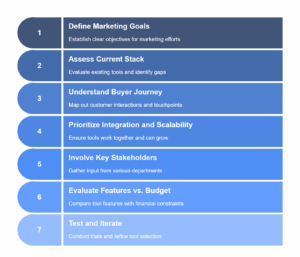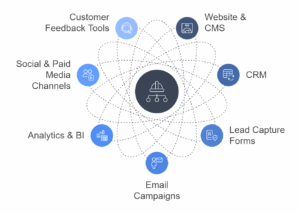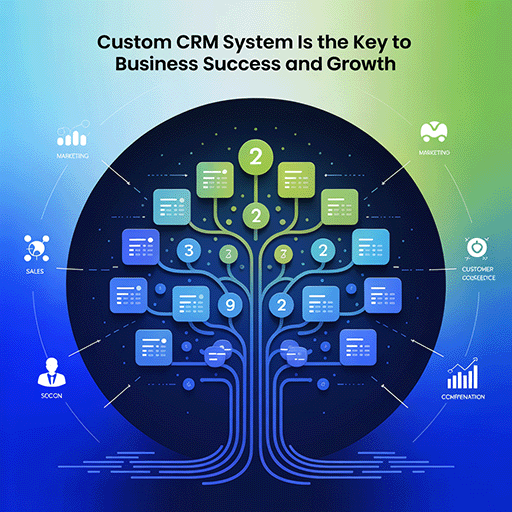Your marketing tech stack is more than just a collection of tools in today’s data-driven world, it serves as the cornerstone of your digital strategy. Campaign performance, personalisation, data streamlining, and return on investment can all be enhanced with the correct mix of marketing technology tools. Selecting the ideal martech stack for your company is more crucial than ever as companies compete more fiercely in digital-first settings.
Marketing departments now allocate over 25% of their overall budgets to martech, indicating its pivotal role in contemporary strategy, according to Gartner. Building a martech stack necessitates clarity, strategic planning, and a solid grasp of your business needs, as there are hundreds of options available, ranging from CRM platforms to automation tools and AI-powered analytics.
What Is a Martech Stack?
A martech stack, which stands for marketing technology stack, is a group of digital tools and platforms used by marketers for campaign planning, execution, measurement, and optimization. Email marketing, social media management, content management systems (CMS), analytics platforms, customer relationship management (CRM), and more are frequently included in these stacks.

Every element of your marketing technology stack should work together as a cohesive ecosystem rather than as separate tools if you want to genuinely optimise the value of your marketing initiatives. Your team can support the customer journey at every stage, from initial awareness and engagement to conversion and post-sale loyalty, thanks to seamless platform integration. You can get a comprehensive picture of your audience and conduct more timely, efficient, and customised outreach when data is freely exchanged between your CRM, automation platforms, analytics tools, and content systems.
In addition to improving customer satisfaction, this alignment increases team productivity in marketing. It reduces manual labour, gets rid of unnecessary tasks, and frees up marketers to concentrate on strategy instead of debugging broken systems. Most significantly, a well-coordinated martech stack helps your company to generate measurable results, including measurable ROI, clear KPIs, and real-time insights that facilitate more intelligent decision-making and ongoing optimisation.
Why Is a Martech Stack Important?
Businesses can prioritise integration and investment when they understand the significance of martech. A well-designed marketing technology stack enables groups to:
- Automate repetitive tasks
- Personalize communications at scale
- Centralize customer data for deeper insights
- Measure campaign effectiveness in real time
- Adapt faster to market trends and customer behavior
Teams frequently struggle with data silos, where important customer insights are imprisoned in disparate and incompatible tools, when they lack the proper marketing tech solutions. Inefficiencies like redundant work, inconsistent messaging, and campaign execution delays result from this lack of integration. Additionally, it results in lost opportunities, such as not interacting with high-value leads at the appropriate moment or not making the most of important data that could help make better decisions. In an increasingly competitive digital landscape, a poorly organised martech stack can impede collaboration, waste money, and ultimately keep marketers from reaching their full potential.
Read this article to find out more about how AI is affecting digital marketing.
What Are the Key Components of a Martech Stack?
The full marketing lifecycle, from attracting leads to nurturing and converting them, should be covered by your martech stack. Important elements consist of:
- Customer Relationship Management (CRM): Centralizes customer data and manages interactions (e.g., HubSpot, Salesforce)
- Email Marketing Tools: Automate and personalize email campaigns (e.g., Mailchimp, ActiveCampaign)
- Marketing Automation Platforms: Streamline workflows and trigger responses (e.g., Marketo, Pardot)
- Content Management Systems (CMS): Publish and manage website content (e.g., WordPress, Webflow)
- Analytics Tools: Track user behavior and campaign metrics (e.g., Google Analytics, Adobe Analytics)
- Social Media Management: Schedule, publish, and analyze content (e.g., Hootsuite, Buffer)
- SEO & SEM Tools: Optimize visibility and manage paid campaigns (e.g., Ahrefs, SEMrush, Google Ads)
- AI & Machine Learning Solutions: Predict trends and personalize user experiences (see examples)

How to Choose the Right Marketing Tech Stack for Your Business
1. Define Your Marketing Goals
Your strategic marketing goals are the cornerstone of a successful martech strategy, so defining them is crucial before assessing any tools. Step back and consider your goals. Do you want to increase qualified traffic to your website to improve lead generation? Is improving customer retention through lifecycle marketing and individualised communication your top priority? Or do you want to increase departmental visibility, decrease manual labour, and expedite team collaboration?
By clearly stating these objectives, you can identify the tools that will be most useful to you and make sure that each addition to your stack has a purpose. Without this clarity, you run the risk of wasting time, money, and effort by purchasing software that seems promising but doesn’t match your real business needs. You can create a marketing technology stack that supports quantifiable results and grows with your business by starting with your goals.
2. Assess Your Current Stack
To find out what tools you are currently using and how well they work for your team, start by performing a thorough martech audit. Find any gaps that lack support or are underutilised in your marketing workflow. At the same time, search for redundancies—tools that have similar functions but don’t add anything new. Focus especially on underutilised tools that might have strong potential but aren’t being used to their full potential because of a lack of awareness, integration, or training. Ascertain which platforms could be more successfully consolidated or integrated, what is effective, and what is out-of-date or inefficient. A clearer path for stack optimisation will be provided by this audit, which will also highlight areas for improvement.
3. Understand Your Buyer Journey
Make a detailed plan of your entire customer journey, including awareness, purchase, and engagement after the sale. Divide it into awareness, consideration, conversion, retention, and advocacy phases, and examine how your target audience engages with your brand at each stage. Determine any areas of friction, pain points, or chances to improve the experience. Next, consider how those interactions can be facilitated by technology. For example, CRM tools can increase retention through tailored follow-ups, while marketing automation can nurture leads during the consideration stage. You can make sure that every platform supports your overall marketing and revenue goals holistically rather than in discrete silos by matching your tech investments with your customer journey.
4. Prioritize Integration and Scalability
Tools that are easy to integrate with your current infrastructure should be given priority when evaluating them. By removing silos and facilitating seamless data transfer between platforms, a well-connected tech stack increases campaign visibility. Seek solutions that have integrated plug-ins, open APIs, and compatibility with third-party services such as your analytics platform, CRM, or CMS. Team productivity is also impacted by integration; disconnected workflows or manual data transfers can cause errors and slow down execution. Examine the tools’ scalability as well. When your team grows, your audience grows, or your campaigns get more complicated, will they still be able to meet your needs? Purchasing scalable tools lowers the need for disruptive migrations in the future and guarantees long-term value.
5. Involve Key Stakeholders
Don’t make decisions about martech in a vacuum. To make sure the tools you select satisfy cross-functional requirements, include representatives from marketing, sales, IT, and even customer support. While sales teams are concerned with lead quality and CRM compatibility, marketing teams might be more concerned with campaign management and personalisation. IT can offer guidance on system integration, data compliance, and security. Involving stakeholders in the selection process promotes alignment, increases internal support, and guarantees more seamless execution. Additionally, it assists in identifying pragmatic needs or issues that might otherwise go unnoticed until it is too late.
6. Evaluate Features vs. Budget
Despite the temptation to choose the platform with the most features, more isn’t always better. Determine what features you need first, then evaluate how various solutions satisfy those needs. Next, evaluate other features that might eventually provide more value. Examine various pricing models, such as pay-per-user, freemium, tiered, monthly versus annual, and compare them to your budget. Remember to account for unforeseen expenses such as integration services, onboarding fees, and continuing support. The perfect tool provides functionality and flexibility without needless complexity. By choosing tools that have a genuine business impact, you can concentrate on ROI rather than just price tags.
7. Test and Iterate
Start with a trial or pilot program before implementing a new tool throughout your entire company. You can test features, usability, and performance in a real-world setting with the majority of marketing tech vendors’ free trials or limited-use accounts. Assign a small group of people to investigate the platform, model important processes, and offer input on its advantages and disadvantages. Get both quantitative and qualitative input. Was the tool easy to use? Did friction decrease as a result? Was it scalable, stable, and quick? Make use of those insights to improve the choice and implementation of your tools. Success with the Martech stack requires constant testing, learning, and optimisation.

Building a Martech Stack That Works for You
When building a martech stack, it’s more important to choose the right tools than to accumulate as many as possible. As your company grows, move into analytics, automation, and artificial intelligence. Start small with necessities like a CRM and email platform. Check out our case study on goods demand forecasting to explore successful martech integrations in action.
Martech Stack Diagram: Visualizing Your Ecosystem
Visualising the connections between each tool across campaigns and departments can be aided by creating a martech stack diagram. This clarity can highlight areas for improved integration and inefficiencies in the workflow.
Typical diagrams could contain:
- Website & CMS
- CRM
- Lead capture forms
- Email campaigns
- Analytics & BI
- Social & paid media channels
- Customer feedback tools

Best Martech Tools to Explore in 2025
- CRM: Salesforce, HubSpot
- Marketing Automation: HubSpot, ActiveCampaign, Klaviyo
- Analytics: Google Analytics 4, Mixpanel
- SEO & SEM: Ahrefs, Moz, Google Ads
- AI Marketing Platforms: Jasper, ChatGPT, Persado (learn more)
- Web Dev & CMS: WordPress, Webflow
These top martech platforms provide scalability, user-friendliness, and robust support for B2B and B2C companies.
Common Mistakes When Selecting Marketing Technology Tools
Although putting together a marketing tech stack is a strategic process, if you’re not careful, you could easily make expensive mistakes. Steer clear of these typical pitfalls to create a stack that produces tangible results:
- Choosing tools based on hype instead of strategy
Simply because competitors are using the newest AI-powered solution or popular tools, it can be tempting to follow suit. But following the crowd without knowing how the tool fits into your plan frequently results in a low return on investment. Always consider your unique business objectives and user requirements when assessing new technologies.
- Overcomplicating the stack with too many platforms
Better performance is not always correlated with more tools. A bloated stack can overwhelm your team, cause confusion, and result in data silos. Prioritise usability over quantity. A stack that is lean and well-integrated is frequently more efficient than one that is crammed with unnecessary or underutilised tools.
- Ignoring integration needs
Your team will have to manually transfer data if your tools are unable to communicate with one another, which will waste time and increase the possibility of mistakes. Verify that every platform easily connects with your analytics software, CRM, and other essential systems. One of the quickest ways to lose data clarity and efficiency is through a lack of integration.
- Not aligning martech with sales and customer service
Marketing doesn’t happen in a vacuum. Poor customer experiences, missed leads, and inconsistent messaging can result from a disjointed tech stack. To ensure that your sales and support teams have a common understanding of the customer journey, make sure your stack meets their needs.
- Skipping internal training and change management
Without adequate onboarding, even the best tools will not work. Results will suffer and adoption will be low if your team is not proficient in using a platform. Spend time on user support, training, and documentation. Just as important as the technology itself is change management.
Optimising the martech stack is a continuous process rather than a one-time event. Plan frequent reviews to monitor usage metrics, gauge tool performance, and determine whether each solution is still fulfilling your business requirements. Remain adaptable, make adjustments as your plan changes, and be ready to retire tools that don’t further your objectives. Your company will be positioned for long-term marketing success and scalable growth with a constantly improved stack.
Final Thoughts: What Tech Stack Should I Use?
When it comes to selecting the ideal marketing tech stack, there is no one-size-fits-all solution. What is successful for one business may not be successful for another. Your company’s marketing objectives, team composition, financial constraints, target market, and level of digital maturity all influence which martech tools are best for you. Your tech stack should be tailored to your specific needs, whether those needs are generating new leads, nurturing current clients, automating processes, or evaluating the effectiveness of campaigns.
Focus on developing a lean, integrated, and flexible martech stack rather than following trends or constructing an excessively complicated system. Select tools that facilitate smooth departmental collaboration, support your business goals, and facilitate easy expansion as your business expands. Prioritising integration is essential because when platforms function well together, your team works more productively, your data remains clean, and your campaigns have a bigger impact.
To remain competitive, flexible, and customer-focused in 2025 and beyond, you need the correct digital marketing technology stack, whether you’re a rapidly growing startup trying to achieve product-market fit or a scaling company trying to maximize multi-channel performance.
Fortunately, we have a wealth of experience creating intelligent marketing tech solutions that work for a range of business models and industries. We have assisted businesses in streamlining processes and optimising marketing return on investment, from choosing the best tools to creating unique integrations and encouraging adoption.
We can also do that for you. Simply get in touch with us, and let’s begin!





